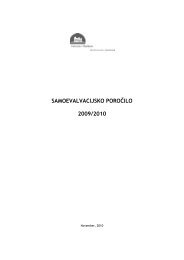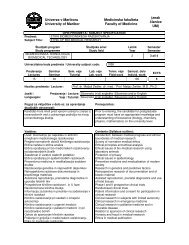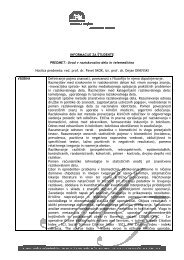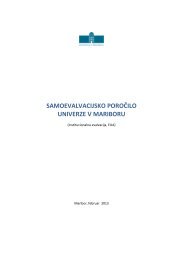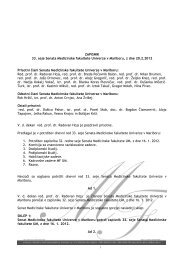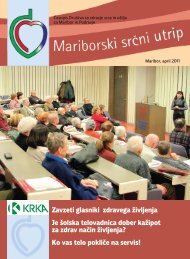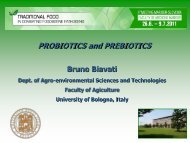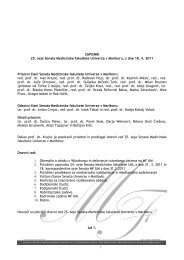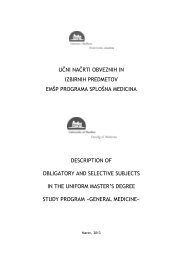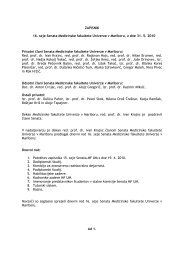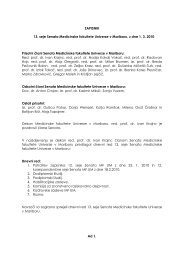Chemical and physical analysis for food products
Chemical and physical analysis for food products
Chemical and physical analysis for food products
You also want an ePaper? Increase the reach of your titles
YUMPU automatically turns print PDFs into web optimized ePapers that Google loves.
12 Juillet 2012, Brest<strong>Chemical</strong> <strong>and</strong> <strong>physical</strong><strong>analysis</strong> <strong>for</strong><strong>food</strong> <strong>products</strong>Philippe Mongondryp.mongondry@groupe-esa.com1
Techniques <strong>for</strong> <strong>food</strong> <strong>products</strong>: what <strong>for</strong>?Quality controlQuantification of nutriments, vitaminsof compoundsIdentification of contaminationDetermination of ingredientsAuthentication of origin of the product2
Foodstuffs should not contain micro-organisms or theirtoxins or metabolites in quantities that present anunacceptable risk <strong>for</strong> human health.(EC Rule No 2073/2005)3
Many analytical chemical <strong>and</strong> <strong>physical</strong> techniques:Electro-<strong>analysis</strong> Q ty of ions Gravimetry Fat or water contentElectrophoresis separation Atomic spectrometry trace elementMolecular spectrometry emission (Fluo); diffusion (Raman) absorption (UV, IR RMN)Mass SpectrometryRadiometry ( 14 C) origin & dateX ray diffusion structural ID Rheometry Flow & structureSensory <strong>analysis</strong>Chromatography4
Preparation of sample <strong>for</strong> <strong>analysis</strong> is critical !!HomogeneisationSolubilisationSeparationAnalysis5
Physical <strong>and</strong> chemical <strong>analysis</strong>• Chromatography• Spectroscopy <strong>and</strong> relatedmicroscopies (UV – visible – IR)• SNIF NMR <strong>and</strong> Mass spectrometrySensory <strong>analysis</strong>• Concepts <strong>and</strong> Basis6
Chromatography or HPLCExtraction <strong>and</strong> preparationin liquid mediaSeparation & Identification7
Chromatography or HPLCHigh Per<strong>for</strong>mance Liquid ChromatographyDifferent Types• Partition chromatography• Normal-phase chromatography• Reversed-phase chromatography (RPC)• Size-exclusion chromatography (SEC)• Ion-exchange chromatography• Bio-affinity chromatographySEC8
Chromatogram ofpesticide in cow milkIdentification ofpolyphenols in wine byUV detectors with HPLC9
MatterSpectroscopy<strong>and</strong> interactions10
interactions light/matterfluorescencediffusionphotoemissionphotontransmissionabsorptionEJ )h. ( Hz)h hc( m( m)h : constante Planck; h= 6,62 x10 -34 J.s -1( 1c)diffraction
From atom to complex molecules12
Biological Molecules• Thous<strong>and</strong>s of different molecules per cell, fast Renew•Complex systemBiological specificity with 'allowed' movement <strong>and</strong>con<strong>for</strong>mation• E(link etc...)reactions, biological <strong>and</strong> thermodynamicparameters• Particularity :trans<strong>for</strong>mation of light energy (chlorophyll)ProteinsGlucideLipidsNucleic acid13
Spectroscopic principleselectromagnetic radiancedomainRadiofrequencyMicro-ondesNuclear Magnetic ResonanceNuclear Quadrupole ResonanceElectronic paramagnetic Resonancemolecular rotations spectrumPhenomena Frequency (Hz) Wave length10 6 to 10 8 300 to 3 m10 10 to 10 12 300 to 0.3 mmInfrared molecular vibrations 10 12 to 3 10 14 300 to 0,8 mVisible <strong>and</strong> ultraviolet Electronic Transitions (external e-) 3 10 14 to 10 16 800 to 10 nmX Rays Electronic Transitions (core e-) 3 10 16 to 10 19 10 to 0.03 nmRays nuclear Transitions 10 19 to 10 220.03 to 0.003nm14
From Far infrared to X-rays…
Spectroscopic principlesEmission of large spectrum of photons (energy)Transmission <strong>and</strong> reflection = nothingAbsorption of energyUV absorption spectrumPowerful photons No! but right ones Yes! 16
Spectroscopic principlesConstruction of absorption spectrumPolychromatic radiationIIAbsLarge spectre of thesourceSpectrale compositionof transmise light17
Spectroscopy UV-visibleHOAbsorption of UV by unsaturated bondsOYESYESONH 2NOYESOQuantitative method,Kinetic of reaction…18
Infrared SpectroscopyPrincipe:Molecule under infrared radiation: vibration <strong>and</strong> rotationSymmetricalstretchingRockingWaggingAntisymmetricalstretchingScissoringTwistinghttp://fr.wikipedia.org/wiki/Spectroscopie_infrarouge19
interactions light/matterAtomic/molecules linkage movements due to which wave lengths in IR?~3.3 m3756 cm-1 3652 cm-1 1595 cm-1~6 m ~10 m ~30 m
Fourier Trans<strong>for</strong>m InfraRed SpectroscopyFingerprint of moleculesspectrometer FTIRUsed <strong>for</strong> samples :Gaz, liquid or solid in powder21
Quanti fy nutritional compounds by FTIR : polyphenols in apple22
Quanti fy the quality of fruits by fast method : NIRFTIR spectrum related to°Brix, pH, dried matteror starch content,maturity, defaults…1.5Sucres1+R11BOHR 2Sucres1932S. Bureau, INRA Avignon0.50-0.5HO-1-1.5Anthocyanes 450AROHChlorophylle 553120012706759767751455Am2P3Am1P3At0P3At1P3At2P3At3P3At4P3At5P3At6P3500 1000 1500 2000 2500Longueurs d’onde (nm)23
Quanti fy the quality of fruits by fast method : Ex. in appleTotal acidRefractometricindex24
Log(1/R)IR microscopy = spatialchemical distribution50 m1.11.00.90.8DNALipidsProteins0.70.65 m0.5DNAProteinsLipidsSections congelées (6µm) de muqueuse intestinale humaineM-P. Bralet <strong>and</strong> F. Le Naour, INSERM U775Hôpital Européen Georges Pompidou, Paris;0.40.30.20.135003000 2500 2000 1500Wavenumbers (cm-1)1000
Quanti fy the quality of milk by fast method : FTIR•Le Milkoscan FT 120 de Foss : Fat, proteins, extrait sec content,proteins•Based on more than 15 years database to calibrate the apparatusMuch faster than st<strong>and</strong>ard chemical <strong>analysis</strong> of reference
Biocristallography with X-raysCristal of proteinDiffracted rays3) recording X-raysimagegoniometer1) cristalRayons X2) diffraction3D Structure of enzymeRNA Polymerase II4) Rebuilding 3D structure
Few examples of microscopiesStudy of resistant bacteria by UVIn situ study of diffusion of antibiotic,through bactéria membrane (first stepresistance to antibiotics).Study of fermentation <strong>and</strong> cookingof bread (bubbles of CO2) by X-rays microtomography
SNIF NMR Site-Specific Natural Isotope Fractionation Nuclear Magnetic ResonanceBased on the absorption of deuterium in plants (Glucose or ethanol)Irregular distribution of De on the Earth due to rotationAddition of different type of sugar in Tequilas29
Mass SpectrometryMain steps of the measurementAimsDetermination of the molecularweight of big molecules (proteins)Quick Identification based ondatabasesUnknown sample30
Mass SpectrometryIdentificationReconstruction by affinity of piecesDepend on position of the picks <strong>and</strong> ratio m/ZCoupling HPLC-MSCoupling techniques is powerful !!31
Sensory <strong>analysis</strong>What consumer underst<strong>and</strong> from different in<strong>for</strong>mation we give him ?How his sensory experiments is influenced by the in<strong>for</strong>mation he has ?What is the impact of a new process or technology on his fondness ?What is important in his purchase behavior ?How to measure the sensory per<strong>for</strong>mance of <strong>products</strong> ?How improve his loyalty ?What consumer looks <strong>for</strong> ?What does he discern in <strong>products</strong> ?32
Sensory <strong>analysis</strong>How objectively measure the tasting <strong>and</strong> thesensorial characteristics of <strong>food</strong> <strong>products</strong>?Factors which influence the choice of a <strong>food</strong> product ( Gains, 1994)Consumer Context productHabitsCulturePersonalityCurrent moodPhysiology (allergy)Time of the dayplaceWith whohowWhy whatSensorial characteristicsNutrimentsPackaging33
Sensory <strong>analysis</strong> of Food <strong>products</strong>Definition:Evaluation of organoleptic properties of a <strong>food</strong> product by human sensesbased on experimental design <strong>and</strong> statistical <strong>analysis</strong> (combination ofinferences or deductive reasoning <strong>and</strong> insight or specific cause <strong>and</strong> effect)ICS 67.240 Sensory <strong>analysis</strong>(ISO st<strong>and</strong>ard)Glossary34
Sensory <strong>analysis</strong>How objectively measure the tasting <strong>and</strong> the sensorial characteristics of <strong>food</strong> <strong>products</strong>?3 categories: Effective, affective <strong>and</strong> perception <strong>analysis</strong>differences preferences Evocations MotivationsDescriptiveTestHedonicTestQualitativeTestTrained panelNaive consumers35
Sensory <strong>analysis</strong>Study consumer behavior <strong>and</strong> motivationto get a better underst<strong>and</strong>ing of his reactionsAims: Identify all reactions, all opinions that consumer haveExample : Reaction in front of the product• Label, design• In<strong>for</strong>mation• Price• Association of these different attributesWhich cap do you prefer ??36
Thank you <strong>for</strong> your attentionp.mongondry@groupe-esa.com37



